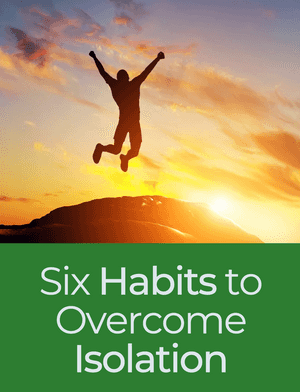
Get the Six Habits for Overcoming Isolation Guide for free
Scientists believe we developed our wide array of cognitive abilities, such as empathy and emotion, to help us cooperate with others. From the moment we are born, we can interpret facial expressions because they can provide clues about the availability of resources. Infants are susceptible to the facial expressions of their primary caregivers because we rely on them to survive.
Listen to the podcast version here
When the human species evolved in groups, breaking away from the tribe and going our own way was a difficult and dangerous choice. Social exclusion, banishment, or abandonment had very tangible and deadly consequences. As a result, our brains became very good at monitoring any perceived social threats. This explains why you may worry about a fight you had with a friend or about being respected at work.
The areas of the brain that light up when we believe we feel excluded have been identified by experiments using functional magnetic resonance imaging (fMRI). Specifically, the anterior cingulate cortex (ACC) becomes active when we experience social distress. Whenever we feel rejected, it is the ACC that triggers painful feelings. The ACC is also involved when we experience physical pain. Thus, physical and social pain shares some of the same circuitry in the brain, which explains why rejection can hurt so badly.
We often interpret failure as rejection in one way or the other. The brain can perceive rejection as threatening our safety and survival, thus activating mechanisms that make us feel distressed. The brain evolved to keep us alive, and it uses these painful mechanisms to get us to do whatever it thinks will lead us back to safety.
Anxiety and depression are also used by the brain to draw your attention to the situation and to do something about it. Depression may actually be adaptive because it can help direct your focus to whatever complex problem you are experiencing. Those who are depressed usually ruminate on the source of their depression to the exclusion of other thoughts and activities. So long as it isn't sustained for extended periods, depression can help you find solutions to the challenges you face.
If you don’t believe failure puts you at risk, you’re unlikely to experience distress, depression, or anxiety. Perceiving failure as a threat is the key to what activates these painful mechanisms in the brain. When you experience failure along with unpleasant feelings, you may also be subject to negative thoughts such as "there must be something wrong with me" or "I can't get anything to work." These thoughts are simply the result of your brain trying to keep you safe. You don’t have to agree with negative thoughts, but it is important to understand why you have them.
You may be tempted to suppress these negative thoughts or distract yourself from them rather than deal with them head-on. You can see this happening all around you; look at all the people you know that distract themselves with tv, video games, shopping, alcohol, or other drugs as coping mechanisms. But you probably already know that distracting yourself from a problem only makes it grow bigger.
Based on the research, there are a few ways we can work with our brains instead of against them to deal with negative feelings and get to where we want to be.
Don't try to suppress negative or unwanted thoughts, no matter how tempting. Although it feels counter-intuitive, the way to get unpleasant thoughts to stop is by first accepting that you have them. Fighting negative thoughts only feeds your feelings of distress, and it is these feelings that cause the brain to activate its protective mechanisms because being in distress makes your brain think your safety is at risk. Several studies found that people who accept unwanted thoughts and emotions cope better with them and have lower rates of depression following stressful life events.
After you have accepted the unpleasant thoughts, begin to reframe your experience. A study on coping with failure revealed that adaptive strategies like acceptance, putting the situation into perspective, refocusing on planning, and positive assessment of what was learned from the failure led to higher self-esteem and mental well-being.
As you process the experience of failure, avoid the temptation to isolate yourself and stay connected to others instead. Doing so will reinforce the belief that you won't be abandoned or left out. There is a wealth of evidence supporting the benefits that social support provides during stressful events.
Finally, as I have spoken about plenty of times, exercise is one of the best ways to release all the negative emotions associated with stressful feelings. Exercise triggers powerful changes in the brain that can reduce tension and anxiety, improve your mood, promote feelings of calm, and energize you. Exercising is also an excellent distraction, enabling you to break out of any vicious negative-thought cycles.
I used to feel like the empty shell of a person just going through the motions of life. People jokingly referred to me as a robot and described me as overly logical without any apparent emotions. I was depressed, anxious, and didn't understand the point of being alive.
I learned the importance of analyzing my needs and wants, consuming information and resources that got me excited about life, doing what needed to be done to close the gap with where I wanted to be, and finding rest within myself to be free from anxiety and disturbances. I also learned how to trust myself and to rely on a solid group of friends allowing me to tap into an enormous amount of strength.
I summarized everything I learned in the Six Habits for Conquering Anxiety and Depression e-book to help you make the same journey. You can sign up for my newsletter on the bottom of this page to receive blog updates (never spam), and you will receive the ebook for free.
Get the Six Habits for Overcoming Isolation Guide for free

